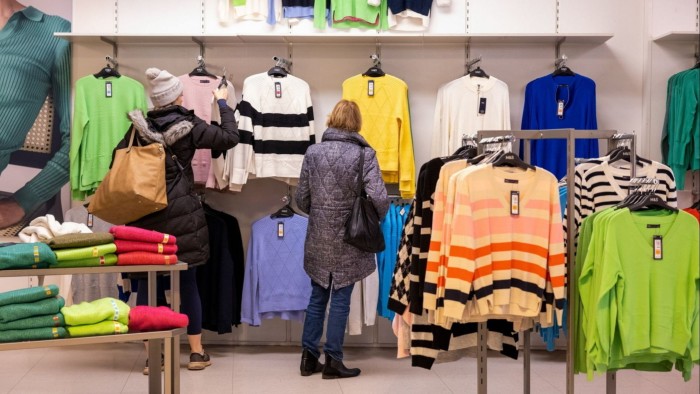A former Marks and Spencer employee-turned-investor had a bone to pick with chair Archie Norman in the summer.
“My problem is noise,” he said at the company’s annual meeting in July, referring to the music played in about a third of the upmarket retailer’s stores. “I’m being bombarded with screeching divas singing at me. I would quite like it to stop.”
Norman admitted the senior team “spent quite a lot of time worrying about the music” but argued that “we do think it sets the mood, it’s what most modern retailers do”.
“I can’t say ‘we’re not going to have music’ — but I know what you mean,” he said, trying to sound a sympathetic note.
Although music or radio has long been a feature in the shops of fashion retailers and large chains such as flat-pack furniture group Ikea to help them create the right ambience and sell more, it is increasingly being rolled out in supermarkets as companies attempt to make extra money by advertising deals and discounts.
Catherine Bell, director of retail media at data company Dunnhumby, which is owned by Tesco, said that while in-store radio had been around since the 1970s, “for many retailers it was installed during the pandemic, and has proven a good way to connect with customers”.
There is evidence that playing music in stores can encourage people to spend more time and money in shops. Research from the University of Bath in 2022 found that there was a 10 per cent uplift in sales during the week when music played in the background in supermarkets — although it can clearly put off some shoppers. At weekends, customers are more relaxed, so the effect is diminished.
“When people are more stressed and mentally tired, pleasant music has a positive experience on their [time] in the store. The effect gets stronger later in the day,” said co-author and senior lecturer Carl-Philip Ahlbom from the university’s school of management.
In-store audio networks are part of so-called retail media, which enables supermarkets to sell advertising, either in store or online, to consumer goods companies seeking measurable returns.
Retail media includes promotions, banners or public address announcements meant to boost sales of certain products, and it has been increasingly lucrative for supermarkets.
Although grocery chains do not break down their revenue or profit from retail media, Tesco’s boss Ken Murphy said in 2023 that the category could be a “meaningful contributor to profit” within three years at the UK’s largest retailer.
Spending on these channels is on track to break through the £7bn mark in 2028, according to IAB UK, the industry body for digital advertising, up from £2.3bn in 2022.
Tesco launched in-store radio in 2020 across more than 2,000 outlets, initially to play safety messages during the Covid-19 pandemic. However, Tesco has increasingly made more lucrative use of it, playing a blend of music and short advertising content about products, special offers and suppliers.
Dunnhumby’s Bell said it could give “brands a voice to say the right thing . . . at the right time”.
M&S also brought back its radio during the same period after an 18-month hiatus starting in 2018. Its previous chief executive Steve Rowe had promised to scrap background music in store after “extensive research and feedback from our customers and colleagues” advising they ditch it. The retail chain does not advertise — most of its products are its own brand — although from time to time it will announce charity tie-ups.
Lidl, meanwhile, trialled music over Christmas in more than a third of its stores after positive feedback on a pilot from customers and staff. It will now decide if it will remain a permanent feature.
Playing music can minimise noise from coolers or air conditioning units “that people tend to have a negative association with, and which could potentially push people out of the store quicker than the retailer would want”, Ahlbom said.
A more upbeat tempo will also typically make people leave faster. “The key to good physical retailing is to try to keep shoppers in [store] as long as possible because . . . you’re more likely to put something into your basket. So I think that’s why they’re doing it.”
Supermarket chain Iceland said the majority of its Food Warehouse stores have in-store radio, which was used “to deliver a combination of music and promotional messages”, as do all of Morrisons’ stores, which also weave in advertisements and earn money from it.
Co-op’s radio plays in more than 2,400 stores, as well as depots and some franchise stores, and it has been running for more than 20 years. It evolved from music-only to having its own shows and presenters, and it now also advertises deals, new product launches and charity tie-ups, among other things.
J Sainsbury, the UK’s second-largest supermarket chain, and premium grocery rival Waitrose said they did not have radios in stores, and nor did value chain Aldi.

Asda has its own radio station, which plays pre-recorded shows daily. But its own employees were irritated last year when it replaced its music service provider and launched a petition calling for the “mentally draining” music to stop, claiming that some stores played the same 20 songs throughout the day.
The supermarket chain said it had reverted to its original provider and this would continue following colleague feedback.
“It could be that people are getting stressed,” Ahlbom said, referring to those who do not respond well to music or radio in stores. It could also have an impact on shoppers’ ability to get around if they were wearing hearing aids, he added.
“I’ve seen quite a lot of retailers that introduced it, then took it away, and then reintroduced it. It might work in certain stores, but not in others because of demographic groups.”


